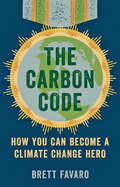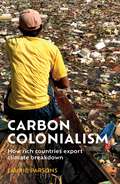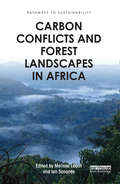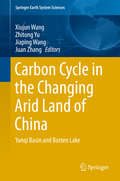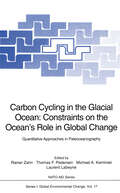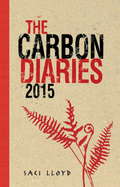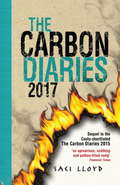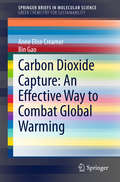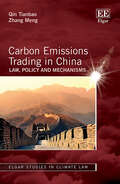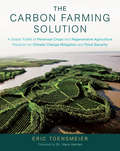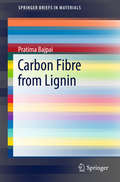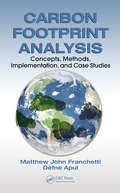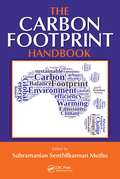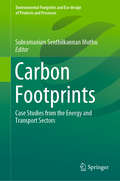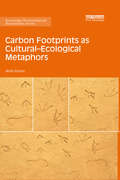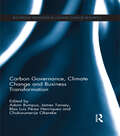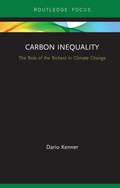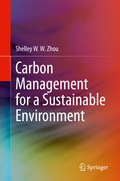- Table View
- List View
The Carbon Code: How You Can Become a Climate Change Hero
by Brett FavaroOur world is getting hotter, and it’s our fault. Our addiction to fossil fuels is destroying not only our ancient planet, but our modern civilization. How can we protect our fragile ecosystems while preserving our way of life? How can we respond to climate change deniers who mock the fact that environmental activists use fossil fuels? In short, how can your average concerned citizen live a normal life in a carbon-based economy without being justifiably called a hypocrite? In The Carbon Code, conservation biologist Brett Favaro answers these thorny questions, offering simple strategies to help you reduce your carbon footprintâ€�without abandoning common sense.Favaro’s Carbon Code of Conduct is based on the four Rs: Reduce, Replace, Refine, and Rehabilitate. After outlining the scientific basics of climate change and explaining the logic of the code he prescribes, the author describes carbon-friendly technologies and behaviors we can adopt in our daily lives. However, he acknowledges that individual action, while vital, is insufficient. To achieve global sustainability, he insists that we must make the fight against climate change "go viral" through conspicuous conservation.The Carbon Code is a tool of empowerment. People don’t need to be climate change experts to be part of the solution! In this book, Brett Favaro shows you how to take ownership of your carbon footprint and adopt a lifestyle of conspicuous conservation that will spur governments and corporations to do the same. Climate-friendly action is the best decision on every dimensionâ€�economics, health and well-being, and social justice. Saving the planet is, after all, about saving ourselves. The Carbon Code provides a framework to do this, and helps you to become a hero in the fight against climate change.
The Carbon Code: How You Can Become a Climate Change Hero
by Brett FavaroOur world is getting hotter, and it’s our fault. Our addiction to fossil fuels is destroying not only our ancient planet, but our modern civilization. How can we protect our fragile ecosystems while preserving our way of life? How can we respond to climate change deniers who mock the fact that environmental activists use fossil fuels? In short, how can your average concerned citizen live a normal life in a carbon-based economy without being justifiably called a hypocrite? In The Carbon Code, conservation biologist Brett Favaro answers these thorny questions, offering simple strategies to help you reduce your carbon footprintâ€�without abandoning common sense.Favaro’s Carbon Code of Conduct is based on the four Rs: Reduce, Replace, Refine, and Rehabilitate. After outlining the scientific basics of climate change and explaining the logic of the code he prescribes, the author describes carbon-friendly technologies and behaviors we can adopt in our daily lives. However, he acknowledges that individual action, while vital, is insufficient. To achieve global sustainability, he insists that we must make the fight against climate change "go viral" through conspicuous conservation.The Carbon Code is a tool of empowerment. People don’t need to be climate change experts to be part of the solution! In this book, Brett Favaro shows you how to take ownership of your carbon footprint and adopt a lifestyle of conspicuous conservation that will spur governments and corporations to do the same. Climate-friendly action is the best decision on every dimensionâ€�economics, health and well-being, and social justice. Saving the planet is, after all, about saving ourselves. The Carbon Code provides a framework to do this, and helps you to become a hero in the fight against climate change.
Carbon colonialism: How rich countries export climate breakdown (G - Reference,information And Interdisciplinary Subjects Ser.)
by Laurie ParsonsAround the world, leading economies are announcing significant progress on climate change. World leaders are queuing up to proclaim their commitment to tackling the climate crisis, pointing to data that shows the progress they have made. Yet the atmosphere is still warming at a record rate, with devastating effects on poverty and precarity in the world’s most vulnerable communities. Are we being deceived?Climate change is devastating the planet, and globalisation is hiding it. This book opens our eyes. Carbon colonialism explores the murky practices of outsourcing a country’s environmental impact, where emissions and waste are exported from rich countries to poorer ones; a world in which corporations and countries are allowed to maintain a clean, green image while landfills in the world’s poorest countries continue to expand, and droughts and floods intensify under the auspices of globalisation, deregulation and economic growth. Taking a wide-ranging, culturally engaged approach to the topic, the book shows how this is not only a technical problem, but a problem of cultural and political systems and structures – from nationalism to economic logic – deeply embedded in our society.
Carbon colonialism: How rich countries export climate breakdown
by Laurie ParsonsAround the world, leading economies are announcing significant progress on climate change. World leaders are queuing up to proclaim their commitment to tackling the climate crisis, pointing to data that shows the progress they have made. Yet the atmosphere is still warming at a record rate, with devastating effects on poverty and precarity in the world’s most vulnerable communities. Are we being deceived?Climate change is devastating the planet, and globalisation is hiding it. This book opens our eyes. Carbon colonialism explores the murky practices of outsourcing a country’s environmental impact, where emissions and waste are exported from rich countries to poorer ones; a world in which corporations and countries are allowed to maintain a clean, green image while landfills in the world’s poorest countries continue to expand, and droughts and floods intensify under the auspices of globalisation, deregulation and economic growth. Taking a wide-ranging, culturally engaged approach to the topic, the book shows how this is not only a technical problem, but a problem of cultural and political systems and structures – from nationalism to economic logic – deeply embedded in our society.
Carbon Conflicts and Forest Landscapes in Africa (Pathways to Sustainability)
by Melissa Leach Ian ScoonesAmidst the pressing challenges of global climate change, the last decade has seen a wave of forest carbon projects across the world, designed to conserve and enhance forest carbon stocks in order to reduce carbon emissions from deforestation and offset emissions elsewhere. Exploring a set of new empirical case studies, Carbon Conflicts and Forest Landscapes in Africa examines how these projects are unfolding, their effects, and who is gaining and losing. Situating forest carbon approaches as part of more general moves to address environmental problems by attaching market values to nature and ecosystems, it examines how new projects interact with forest landscapes and their longer histories of intervention. The book asks: what difference does carbon make? What political and ecological dynamics are unleashed by these new commodified, marketized approaches, and how are local forest users experiencing and responding to them? The book’s case studies cover a wide range of African ecologies, project types and national political-economic contexts. By examining these cases in a comparative framework and within an understanding of the national, regional and global institutional arrangements shaping forest carbon commoditisation, the book provides a rich and compelling account of how and why carbon conflicts are emerging, and how they might be avoided in future. This book will be of interest to students of development studies, environmental sciences, geography, economics, development studies and anthropology, as well as practitioners and policy makers.
Carbon Conflicts and Forest Landscapes in Africa (Pathways to Sustainability)
by Melissa Leach Ian ScoonesAmidst the pressing challenges of global climate change, the last decade has seen a wave of forest carbon projects across the world, designed to conserve and enhance forest carbon stocks in order to reduce carbon emissions from deforestation and offset emissions elsewhere. Exploring a set of new empirical case studies, Carbon Conflicts and Forest Landscapes in Africa examines how these projects are unfolding, their effects, and who is gaining and losing. Situating forest carbon approaches as part of more general moves to address environmental problems by attaching market values to nature and ecosystems, it examines how new projects interact with forest landscapes and their longer histories of intervention. The book asks: what difference does carbon make? What political and ecological dynamics are unleashed by these new commodified, marketized approaches, and how are local forest users experiencing and responding to them? The book’s case studies cover a wide range of African ecologies, project types and national political-economic contexts. By examining these cases in a comparative framework and within an understanding of the national, regional and global institutional arrangements shaping forest carbon commoditisation, the book provides a rich and compelling account of how and why carbon conflicts are emerging, and how they might be avoided in future. This book will be of interest to students of development studies, environmental sciences, geography, economics, development studies and anthropology, as well as practitioners and policy makers.
Carbon Counter: Calculate Your Carbon Footprint (Collins Gem)
by Mark LynasWhat effect are you having on the environment? If you buy Kenyan green beans what is the CO2 cost? What about your journey to work, your fridge or your clothes? The Gem Carbon Counter is your portable instant green reckoner.
Carbon Cycle in the Changing Arid Land of China: Yanqi Basin and Bosten Lake (Springer Earth System Sciences)
by Xiujun Wang Zhitong Yu Jiaping Wang Juan ZhangThis book integrates the analyses of organic carbon and carbonate accumulation in soil and lake sediment in a typical arid region of China that has experienced significant climate and land-use changes.It demonstrates that carbonate accumulation greatly exceeds organic carbon in both soil and sediment. It also shows that intensive cropping with sound land management in the arid land not only increases soil organic carbon stock, but also enhances accumulation of soil carbonate, particularly in subsoils. Carbon accumulation in the lake sediment increased between 1950 and 2000, after which it declined, and the authors explore how human activity and climate change may have caused the changes in carbon burial in the lake sediment.This book is of interest to researchers in a number of fields such as soil science, limnology and global change, as well as to the policy-makers.
Carbon Cycling in the Glacial Ocean: Quantitative Approaches in Paleoceanography (Nato ASI Subseries I: #17)
by Rainer Zahn Thomas F. Pedersen Michael A. Kaminski Laurent LabeyrieA comprehensive progress report on the multi-disciplinary field of ocean and climate change research is given. It compiles introductory background papers and leading scientific results on the ocean-atmosphere carbon cycle with emphasis on the ocean's carbon inventory and the various components involved. The relationship between plankton productivity, carbon fixation, oceanic PCO2 and climate change is investigated from the viewpoint of long-term climatic change during the late Quaternary cycles of ice ages and warm ages. The various approaches range from micropaleontology over organic and trace element geochemistry to molecular isotope geochemistry.
The Carbon Diaries 2015: Book 1 (Carbon Diaries)
by Saci LloydIt's January 1st, 2015, and the UK is the first nation to introduce carbon dioxide rationing, in a drastic bid to combat climate change. As her family spirals out of control, Laura Brown chronicles the first year of rationing with scathing abandon. Will her mother become one with her inner wolf? Will her sister give up her weekends in Ibiza? Does her father love the pig more than her? Can her band The Dirty Angels make it big? And will Ravi Datta ever notice her? In these dark days, Laura deals with the issues that really matter: love, floods and pigs. The Carbon Diaries 2015 is one girl's drastic bid to stay sane in a world unravelling at the seams.
The Carbon Diaries 2017: Book 2
by Saci LloydIt's over a year since her last diary and Laura Brown is now in her first year of university in London, a city still struggling to pull itself together in the new rationing era. Laura's right in the heart of it; her band, the dirty angels, are gigging all over town until a police crackdown on rioting students forces them out of the city. After a brief exile on her parents' farm, the angels set off in a battered VW bus on a tour of Europe with the fabulous Tiny Chainsaws in the Distance.The tour soon unravels, however, in an increasingly dramatic sequence of events that include drought in Europe and Africa, a tidal-wave of desperate immigrants, a water war in the Middle East and a city-wide face off with the army in London. Not to mention infidelity, betrayal, friendship, love and massive courage.How long can Laura distance herself from the struggle? And more importantly, how can she keep her style and hope alive in a world on the edge of madness?
Carbon Dioxide Capture: An Effective Way to Combat Global Warming (SpringerBriefs in Molecular Science)
by Anne Elise Creamer Bin GaoThis topical brief summarizes the various options available for carbon capture and presents the current strategies involved in CO2 reduction. The authors focus on current CO2 capture technologies that facilitate the reduction of greenhouse gas (CO2) emissions and reduce global warming. This short study will interest environmental researchers, teachers and students who have an interest in global warming.
Carbon Emissions Trading in China: Law, Policy and Mechanisms (Elgar Studies in Climate Law)
by Qin Tianbao Zhang MengEmissions Trading Systems (ETS) have been hailed as a game changer for the evolving climate crisis. This book provides an in-depth analysis of China’s carbon ETS, including its legal and policy frameworks, carbon market mechanisms, and international and comparative implications.With nine cutting-edge topics divided into three thematic parts, this comprehensive book probes the essential concepts, contemporary research, and key elements of carbon emissions trading in China. Multidisciplinary in scope, the book draws on insights from law, policy, economics, environmental management, and geopolitics, to provide a comprehensive and nuanced analysis of the development of carbon emissions trading in China. Placing China’s carbon ETS within the broader context of international efforts to address climate change, it provides a comparative perspective with international value.This book will be an essential resource for scholars and researchers of international and comparative climate law and policy, environmental management, economics, and climate politics. It will prove an indispensable guide for students of Chinese law, climate law, environmental policy, and comparative environmental law. Practitioners, policymakers, and government officials working in climate governance seeking the state-of-the-art of the development of ETS in China will also benefit greatly from its insights.
The Carbon Farming Solution: A Global Toolkit of Perennial Crops and Regenerative Agriculture Practices for Climate Change Mitigation and Food Security
by Eric Toensmeier Dr Hans HerrenWith carbon farming, agriculture ceases to be part of the climate problem and becomes a critical part of the solution Agriculture is rightly blamed as a major culprit of our climate crisis. But in this groundbreaking new book, Eric Toensmeier argues that agriculture—specifically, the subset of practices known as “carbon farming”—can, and should be, a linchpin of a global climate solutions platform. Carbon farming is a suite of agricultural practices and crops that sequester carbon in the soil and in above-ground biomass. Combined with a massive reduction in fossil fuel emissions—and in concert with adaptation strategies to our changing environment— carbon farming has the potential to bring us back from the brink of disaster and return our atmosphere to the “magic number” of 350 parts per million of carbon dioxide. Toensmeier’s book is the first to bring together these powerful strategies in one place, including in-depth analysis of the available research and, where research is lacking, a discussion of what it will take to get us there. Carbon farming can take many forms. The simplest practices involve modifications to annual crop production. Although many of these modifications have relatively low sequestration potential, they are widely applicable and easily adopted, and thus have excellent potential to mitigate climate change if practiced on a global scale. Likewise, grazing systems such as silvopasture are easily replicable, don’t require significant changes to human diet, and—given the amount of agricultural land worldwide that is devoted to pasture—can be important strategies in the carbon farming arsenal. But by far, agroforestry practices and perennial crops present the best opportunities for sequestration. While many of these systems are challenging to establish and manage, and would require us to change our diets to new and largely unfamiliar perennial crops, they also offer huge potential that has been almost entirely ignored by climate crusaders. Many of these carbon farming practices are already implemented globally on a scale of millions of hectares. These are not minor or marginal efforts, but win-win solutions that provide food, fodder, and feedstocks while fostering community self-reliance, creating jobs, protecting biodiversity, and repairing degraded land—all while sequestering carbon, reducing emissions, and ultimately contributing to a climate that will remain amenable to human civilization. Just as importantly to a livable future, these crops and practices can contribute to broader social goals such as women’s empowerment, food sovereignty, and climate justice. The Carbon Farming Solution does not present a prescription for how cropland should be used and is not, first and foremost, a how-to manual, although following up on references in a given section will frequently provide such information. Instead, The Carbon Farming Solution is—at its root—a toolkit. It is the most complete collection of climate-friendly crops and practices currently available. With this toolkit, farmers, communities, and governments large and small, can successfully launch carbon farming projects with the most appropriate crops and practices to their climate, locale, and socioeconomic needs. Toensmeier’s ultimate goal is to place carbon farming firmly in the center of the climate solutions platform, alongside clean solar and wind energy. With The Carbon Farming Solution, Toensmeier wants to change the discussion, impact policy decisions, and steer mitigation funds to the research, projects, and people around the world who envision a future where agriculture becomes the protagonist in this fraught, urgent, and unprecedented drama of our time. Citizens, farmers, and funders will be inspired to use the tools presented in this important new book to transform degraded lands around the world into productive carbon-storing landscapes.
Carbon Fibre from Lignin (SpringerBriefs in Materials)
by Pratima BajpaiThis book presents detailed information on the production and properties of carbon fibers derived from lignin precursors. Focusing on future directions in the carbon fiber industry, it also introduces a novel process for obtaining high-purity lignin, a key aspect in the manufacture of high-quality carbon fiber. Carbon fiber is currently the most preferred lightweight manufacturing material and is rapidly becoming the material of choice for manufacturers around the world. Although more than 80% of commercial carbon fiber is estimated to use PAN (polyacrylonitrile) as a precursor, carbon fiber manufactured from PAN is expensive and therefore its application is limited to high-performance structural materials. Lignin is the second most abundant biopolymer in nature after cellulose and offers a carbon-rich, renewable resource. As a byproduct of the pulp and paper industry and the production of cellulosic ethanol, lignin is also available at low cost, making it an economically attractive alternative to PAN for the production of carbon fibers, as highlighted in this book. The information presented will be of interest to all those involved in the investigation of carbon fiber materials, carbon fiber manufacturers and carbon fiber users.
Carbon Footprint Analysis: Concepts, Methods, Implementation, and Case Studies
by Matthew John Franchetti Defne ApulThe negative impacts of carbon emissions from human activities continue to dramatically reshape the environmental, political, and social landscape. These impacts coupled with cap and trade schemes iterate the importance and need to properly measure and reduce greenhouse gas emissions. Carbon Footprint Analysis: Concepts, Methods, Implementation, an
The Carbon Footprint Handbook
by Subramanian Senthilkannan MuthuThorough and detailed, The Carbon Footprint Handbook encompasses all areas of carbon footprint, including the scientific elements, methodological and technological aspects, standards, industrial case studies, and communication of carbon footprint results. Written and edited by an international group of experts, the far-ranging topics on carbon foot
Carbon Footprints: Industrial Case Studies (EcoProduction)
by Subramanian Senthilkannan MuthuThis book presents revealing case studies on carbon footprint calculation and mitigation in various industrial sectors. There are numerous sectors whose carbon footprints need to be calculated, and effective ways to mitigate the greenhouse-gas emissions from these sectors need to be found. Using representative case studies, this book highlights the carbon footprint of national power generation systems, crude glycerol production plants and the Brazilian highway network system, as well as the integration of renewable energy sources in expansion planning, so as to promote and implement power system decarbonization.
Carbon Footprints as Cultural-Ecological Metaphors (Routledge Environmental Humanities)
by Anita GirvanThrough an examination of carbon footprint metaphors, this books demonstrates the ways in which climate change and other ecological issues are culturally and materially constituted through metaphor. The carbon footprint metaphor has achieved a ubiquitous presence in Anglo-North American public contexts since the turn of the millennium, yet this metaphor remains under-examined as a crucial mediator of political responses to the urgent crisis of climate change. Existing books and articles on the carbon footprint typically treat this metaphor as a quantifying metric, with little attention to the shifting mediations and practices of the carbon footprint as a metaphor. This gap echoes a wider gap in understanding metaphors as key figures in mediating more-than-human relations at a time when such relations profoundly matter. As a timely intervention, this book addresses this gap by using insights from environmental humanities and political ecology to discuss carbon footprint metaphors in popular and public texts. This book will be of great interest to researchers and students of environmental humanities, political ecology, environmental communication, and metaphor studies.
Carbon Footprints as Cultural-Ecological Metaphors (Routledge Environmental Humanities)
by Anita GirvanThrough an examination of carbon footprint metaphors, this books demonstrates the ways in which climate change and other ecological issues are culturally and materially constituted through metaphor. The carbon footprint metaphor has achieved a ubiquitous presence in Anglo-North American public contexts since the turn of the millennium, yet this metaphor remains under-examined as a crucial mediator of political responses to the urgent crisis of climate change. Existing books and articles on the carbon footprint typically treat this metaphor as a quantifying metric, with little attention to the shifting mediations and practices of the carbon footprint as a metaphor. This gap echoes a wider gap in understanding metaphors as key figures in mediating more-than-human relations at a time when such relations profoundly matter. As a timely intervention, this book addresses this gap by using insights from environmental humanities and political ecology to discuss carbon footprint metaphors in popular and public texts. This book will be of great interest to researchers and students of environmental humanities, political ecology, environmental communication, and metaphor studies.
Carbon Governance, Climate Change and Business Transformation (Routledge Advances in Climate Change Research)
by Adam G. Bumpus James Tansey Blas L. Pérez Henríquez Chukwumerije OkerekeTransformation to a low carbon economy is a central tenet to any discussion on the solutions to the complex challenges of climate change and energy security. Despite advances in policy, carbon management and continuing development of clean technology, fundamental business transformation has not occurred because of multiple political, economic, social and organisational issues. Carbon Governance, Climate Change and Business Transformation is based on leading academic and industry input, and three international workshops focused on low carbon transformation in leading climate policy jurisdictions (Canada, USA and the UK) under the international Carbon Governance Project (CGP) banner. The book pulls insights from this innovative collaborative network to identify the policy combinations needed to create transformative change. It explores fundamental questions about how governments and the private sector conceptualize the problem of climate change, the conditions under which business transformation can genuinely take place and key policy and business innovations needed. Broadly, the book is based on emerging theories of multi-levelled, multi-actor carbon governance, and applies these ideas to the real world implications for tackling climate change through business transformation. Conceptually and empirically, this book stimulates both academic discussion and practical business models for low carbon transformation.
Carbon Governance, Climate Change and Business Transformation (Routledge Advances in Climate Change Research)
by Adam Bumpus James Tansey Chukwumerije Okereke Blas Luis Pérez HenríquezTransformation to a low carbon economy is a central tenet to any discussion on the solutions to the complex challenges of climate change and energy security. Despite advances in policy, carbon management and continuing development of clean technology, fundamental business transformation has not occurred because of multiple political, economic, social and organisational issues. Carbon Governance, Climate Change and Business Transformation is based on leading academic and industry input, and three international workshops focused on low carbon transformation in leading climate policy jurisdictions (Canada, USA and the UK) under the international Carbon Governance Project (CGP) banner. The book pulls insights from this innovative collaborative network to identify the policy combinations needed to create transformative change. It explores fundamental questions about how governments and the private sector conceptualize the problem of climate change, the conditions under which business transformation can genuinely take place and key policy and business innovations needed. Broadly, the book is based on emerging theories of multi-levelled, multi-actor carbon governance, and applies these ideas to the real world implications for tackling climate change through business transformation. Conceptually and empirically, this book stimulates both academic discussion and practical business models for low carbon transformation.
Carbon Inequality: The Role of the Richest in Climate Change (Routledge Focus on Environment and Sustainability)
by Dario KennerWith a specific focus on the United States and the United Kingdom, Carbon Inequality studies the role of the richest people in contributing to climate change via their luxury consumption and their investments. In an innovative contribution, it attempts to quantify personal responsibility for shareholdings in large fossil fuel companies. This book explores the implications of the richest people’s historic responsibility for global warming, the impacts of which affect them less than most others in global society. Kenner analyses how the richest people running large oil and gas companies have successfully used their political influence to lobby the US and UK government. This assessment of their growing political power is particularly pertinent at a time of increasing inequality and growing public awareness of the impact of climate change. The book also highlights the crucial role of the richest in blocking the low-carbon transition in the US and the UK, exploring how this could be countered to ensure fossil fuels are fully replaced by renewable energy. This book will be of great relevance to scholars and policy makers with an interest in inequality, climate change and sustainability transitions.
Carbon Inequality: The Role of the Richest in Climate Change (Routledge Focus on Environment and Sustainability)
by Dario KennerWith a specific focus on the United States and the United Kingdom, Carbon Inequality studies the role of the richest people in contributing to climate change via their luxury consumption and their investments. In an innovative contribution, it attempts to quantify personal responsibility for shareholdings in large fossil fuel companies. This book explores the implications of the richest people’s historic responsibility for global warming, the impacts of which affect them less than most others in global society. Kenner analyses how the richest people running large oil and gas companies have successfully used their political influence to lobby the US and UK government. This assessment of their growing political power is particularly pertinent at a time of increasing inequality and growing public awareness of the impact of climate change. The book also highlights the crucial role of the richest in blocking the low-carbon transition in the US and the UK, exploring how this could be countered to ensure fossil fuels are fully replaced by renewable energy. This book will be of great relevance to scholars and policy makers with an interest in inequality, climate change and sustainability transitions.
Carbon Management for a Sustainable Environment
by Shelley W. ZhouThis textbook presents students with a systematic approach for the quantification and management of greenhouse gas emissions (GHG) and provides best practices for optimal carbon management and quantification. The book begins with an overview of climate change basics and goes on to discuss carbon footprint measurements, carbon management concepts, and concludes by presenting carbon reduction solutions with applications for green buildings, smart transportation, waste management, and carbon trading and offsetting. The author provides practical examples and carbon management models that support innovative reduction solutions and presents a roadmap for the implementation and development of carbon management strategies, making it a useful resource for both upper undergraduate and graduate students as well as practitioners seeking a comprehensive framework to conduct carbon management.
